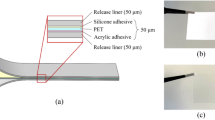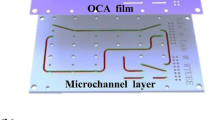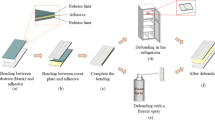Abstract
Thermoplastics have been widely used as bulk material for microfluidic devices in biological and medical applications. One of the critical steps in chip fabrication is bonding: substrate (usually with fabricated microchannels) is bonded with a cover plate to seal the microchannel. This study proposes a low-cost PMMA (polymethyl methacrylate)-based microfluidic chip bonding method using blue diode laser transmission welding. Conventional PMMA substrate is transparent to the blue diode laser (445 nm in wavelength) used in this study, to achieve the transmission welding with the low-cost blue diode laser, PMMA substrate was custom-made with the addition of light-absorbing additives. Thus, the laser beam can transmit through PMMA cover plate (without light-absorbing additives) and absorbed on the surface of PMMA substrate (with light-absorbing additives). The absorbed laser energy converts to heat and finally achieves a stable bonding between the substrate and cover plate. Compared with the conventional bonding method for thermoplastic-based microfluidics, such as thermal fusion bonding and adhesive/chemical bonding, the proposed bonding method achieved a higher bonding strength without contaminating the microchannel with adhesives and organic solvents. The proposed low-cost and rapid bonding method could have wide application potential in the field of point-of-care diagnostic devices.









Similar content being viewed by others
References
C. Iliescu, H. Taylor, M. Avram, J. Miao, S. Franssila, A practical guide for the fabrication of microfluidic devices using glass and silicon. Biomicrofluidics 6(1), 016505 (2012)
E. Verpoorte, N.F. De Rooij, Microfluidics meets MEMS. Proc. IEEE 91(6), 930–953 (2003)
D.-J. Shim, H.-W. Sun, S.T. Vengallatore, S.M. Spearing, Damage and failure in silicon-glass-metal microfluidic joints for high-pressure MEMS devices. J. Microelectromech. Syst. 15(1), 246–258 (2006)
H. Becker, C. Gärtner, Polymer microfabrication technologies for microfluidic systems. Anal. Bioanal. Chem. 390(1), 89–111 (2008)
Y. Fan, Low-cost microfluidics: materials and methods. Micro & Nano Letters 13(10), 1367–1372 (2018)
K.M. Raj, S. Chakraborty, PDMS microfluidics: a mini review. J Appl Poly Sci. 137(27), 48958 (2020)
E. Gencturk, S. Mutlu, K.O. Ulgen, Advances in microfluidic devices made from thermoplastics used in cell biology and analyses. Biomicrofluidics 11(5), 051502 (2017)
S.H. Tan, N.-T. Nguyen, Y.C. Chua, T.G. Kang, Oxygen plasma treatment for reducing hydrophobicity of a sealed polydimethylsiloxane microchannel. Biomicrofluidics 4(3), 032204 (2010)
H. Klank, J.P. Kutter, O. Geschke, CO 2-laser micromachining and back-end processing for rapid production of PMMA-based microfluidic systems. Lab Chip 2(4), 242–246 (2002)
H. Li, Y. Fan, R. Kodzius, I.G. Foulds, Fabrication of polystyrene microfluidic devices using a pulsed CO 2 laser system. Microsyst. Technol. 18(3), 373–379 (2012)
S.A. Aghvami et al., Rapid prototyping of cyclic olefin copolymer (COC) microfluidic devices. Sens. 247, 940–949 (2017)
S. Liu, Y. Fan, K. Gao, Y. Zhang, Fabrication of Cyclo-olefin polymer-based microfluidic devices using CO2 laser ablation. Mater Res Exp 5(9), 095305 (2018)
M. Kim, B.-U. Moon, C.H. Hidrovo, Enhancement of the thermo-mechanical properties of PDMS molds for the hot embossing of PMMA microfluidic devices. J. Micromech. Microeng. 23(9), 095024 (2013)
Y.-K. Hsieh et al., Direct micromachining of microfluidic channels on biodegradable materials using laser ablation. Polymers 9(7), 242 (2017)
D.J. Guckenberger, T.E. de Groot, A.M. Wan, D.J. Beebe, E.W. Young, Micromilling: a method for ultra-rapid prototyping of plastic microfluidic devices. Lab Chip 15(11), 2364–2378 (2015)
X. Ma, R. Li, Z. Jin, Y. Fan, X. Zhou, Y. Zhang, Injection molding and characterization of PMMA-based microfluidic devices. Microsyst. Technol. 26(4), 1317–1324 (2020)
R. Sivakumar, N.Y. Lee, Microfluidic device fabrication mediated by surface chemical bonding. Analyst 145(12), 4096–4110 (2020)
S.A.M. Shaegh et al., Rapid prototyping of whole-thermoplastic microfluidics with built-in microvalves using laser ablation and thermal fusion bonding. Sens. 255, 100–109 (2018)
C.S. Thompson, A.R. Abate, Adhesive-based bonding technique for PDMS microfluidic devices. Lab Chip 13(4), 632–635 (2013)
S. Kecili, H.C. Tekin, Adhesive bonding strategies to fabricate high-strength and transparent 3D printed microfluidic device. Biomicrofluidics 14(2), 024113 (2020)
S. Kratz et al., Characterization of four functional biocompatible pressure-sensitive adhesives for rapid prototyping of cell-based lab-on-a-chip and organ-on-a-chip systems. Sci. Rep. 9(1), 1–12 (2019)
I. Ogilvie, V. Sieben, C. Floquet, R. Zmijan, M. Mowlem, H. Morgan, Reduction of surface roughness for optical quality microfluidic devices in PMMA and COC. J. Micromech. Microeng. 20(6), 065016 (2010)
Author information
Authors and Affiliations
Corresponding author
Ethics declarations
Conflicts of interest
The authors declare no conflict of interest.
Additional information
Publisher's Note
Springer Nature remains neutral with regard to jurisdictional claims in published maps and institutional affiliations.
Rights and permissions
Springer Nature or its licensor (e.g. a society or other partner) holds exclusive rights to this article under a publishing agreement with the author(s) or other rightsholder(s); author self-archiving of the accepted manuscript version of this article is solely governed by the terms of such publishing agreement and applicable law.
About this article
Cite this article
Li, L., Huang, Y. & Fan, Y. Low-cost irreversible blue diode laser transmission welding of poly(methyl methacrylate)-based microfluidics. Appl. Phys. A 128, 1098 (2022). https://doi.org/10.1007/s00339-022-06209-1
Received:
Accepted:
Published:
DOI: https://doi.org/10.1007/s00339-022-06209-1




